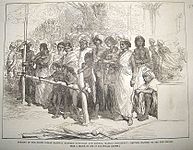 | |
 | |
| Overview | |
|---|---|
| Headquarters | York Street, Westminster, London, UKGBI (R. O.) Trichinopoly, Madras Presidency, British Raj (Operations) |
| Reporting mark | SIR |
| Locale | Madras Presidency |
| Dates of operation | 1 July 1874 (1874-07-01)–13 April 1951 (1951-04-13) (76 years, 9 months and 13 days) |
| Predecessor | Great Southern Railway of India Carnatic Railway |
| Successor | Southern Railway zone |
| Technical | |
| Previous gauge | 1,000 mm (3 ft 3+3⁄8 in) |
The South Indian Railway Company operated a number of 1,000 mm (3 ft 3+3⁄8 in) gauge lines in South India from 1874 to 1951.
History
The Great Southern of India Railway Company was established with its headquarters in England in 1853. The Carnatic Railway Company was founded in 1869. The two companies merged in 1874 to form the South Indian Railway Company. The new firm was registered in London in 1890 with Trichinopoly as its headquarters. In 1891, the Pondicherry Railway Company (incorporated in 1845) merged with the South Indian Railway Company. The company moved its headquarters later to, Chennai Central. The company operated a suburban electric train service for Madras city from May 1931 onwards. The South Indian Railway Company was nationalized in 1944. On 1 April 1951, the South Indian Railway Company, the Madras and Southern Mahratta Railway Company and the Mysore Railway Company were merged to form the Southern Railway zone of the Indian Railways.
-
 Opening of the South Indian Railway between Tuticorin and Madura by Madras Presidency. "Natives waiting to see the Prince in 1876"
Opening of the South Indian Railway between Tuticorin and Madura by Madras Presidency. "Natives waiting to see the Prince in 1876"
-
 An up-country railway station
An up-country railway station
Rolling stock

By the end of 1877 the company owned 97 steam locomotives, 366 coaches and 1643 goods wagons. By 1936, the rolling stock had increased to 557 locomotives, 27 railcars, 1610 coaches and 9779 freight wagons.
Classification
It was labeled as a Class I railway according to Indian Railway Classification System of 1926.
Conversion to broad gauge
The railway lines were converted to 1,676 mm (5 ft 6 in) broad gauge in the 1990s.
See also
References
Notes
- South Indian Railway Company 2015, Chapter 1.
- ^ "Indian Tramway Limited". Herepath's Railway and Commercial Journal. 32 (1595): 3. 1 January 1870.
- Report on the Administration of the Madras Presidency During the Year 1875-76. Government Press. 1877. p. 260.
- Archiv für Post und Telegraphie, Band 7 (in German). Reichsdruckerei, Berlin. 1879. p. 62–63.
- World Survey of Foreign Railways. Transportation Division, Bureau of foreign and domestic commerce, Washington D.C. 1936. p. 219.
- "Indian Railway Classification". Retrieved 10 November 2022.
- World Survey of Foreign Railways. Transportation Division, Bureau of foreign and domestic commerce, Washington D.C. 1936. p. 210–219.
Bibliography
- South Indian Railway Company (2004) . Illustrated guide to the South Indian Railway (Incorporated in England): including the Tanjore District Board, Pondicherry, Peralam-Karaikkal, Travancore State, Cochin State, Coimbatore District Board, Tinnevelly-Tiruchendur, and the Nilgiri Railways. New Delhi: Asian Educational Services. ISBN 8120618890.
- South Indian Railway Company (2015) . The Illustrated Guide to the South Indian Railway. Stroud, Gloucestershire, England: Amberley Publishing. ISBN 9781445650814.
- Subramhanyan, S (2010). Marvels of the South Indian Railway: 1859 - 1951. Tiruchchirappalli: Railway Heritage Centre, Southern Railway, Tiruchchirappally Division. ISBN 9788192146607.
External links
Categories:- Transport in Madurai
- Transport in Chennai
- Rail transport in Tiruchirappalli
- Defunct railway companies of India
- Southern Railway zone
- Rail transport in Tamil Nadu
- Railway companies established in 1874
- Railway companies disestablished in 1951
- 1874 establishments in British India
- 1951 disestablishments in India
- Indian companies established in 1874